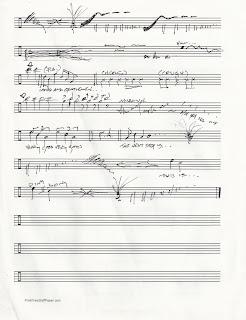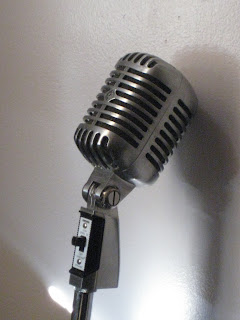I decided to feature the two main things I've been doing for the last couple years: playing music and conducting interviews. Since the interviews were audio recordings, I had to use archive footage for images of the interviewees. I wanted to go super lo-fi, but unfortunately my version of FCE doesn't have the bad tv or vignette filters. The best I could do was record directly from my computer screen and then mess with the levels.
Monday, December 26, 2011
Documentary Review – Seltzer Works
I was struck initially by the Seltzer Works documentary mostly because I've always loved the aesthetic of classic cocktail culture. The documentary also takes full advantage of the steampunk aesthetic of the bottling plant itself – except it's the original equipment and not a retro imitation. The cinematographer obviously spent plenty of time getting a wide variety of footage so there would be plenty to work with in the editing room: a talking head interview, and interview while working, b-roll footage of a worker performing various tasks, and great shots of the bottles and machinery utilizing the narrow depth of field and shifting focal plane techniques. The colors of the bottles, the old wooden crates, the equipment, make it difficult not to get immediately drawn into the character of the plant.
I assume only a fraction of the original interview was used for the film, but it was edited in a very coherent, well-structured way, starting with the history, then describing seltzer (with its great candid shot of Kenny Gomberg spraying seltzer into his mouth), then addressing the current state of the industry. Having Gomberg sit for a talking head as well as having him talk while working was very effective as it not only added visual interest, but I imagine he spoke differently, or at least addressed different topics, while he was sitting and while he was at the bottling machine.
I also appreciated the interview because there is an actual story there, as opposed to the other two selections for this assignment, which were more contemplative portraits. I have nothing against video portraits – they can be beautiful works of art, such as the amazing crane footage in City of Cranes and the gritty realism of Office – but I need to be in a certain mood to watch them. I'm always up for a good story. Even being able to include once sentence like the reference to the guy who bottled seltzer for the tsar of Russia can spark the audience to ponder all kinds of questions about those characters. Is that all this bottler did, or was it part-time? How did he get into it? Did the tsar really love seltzer so much that he needed an exclusive bottler?
Finally, the music in Seltzer Works was also well-selected. The reflective vibraphone music at the beginning and the end suits the images of bubbling seltzer and slowing rotating machine parts. Then the upbeat music paired with the activity of the bottler makes a great midpoint to the piece.
Photo Collage
This photo was taken at an exhibit at MoMa PS1. It was a completely empty room with a floor covered in old LPs. The walls were blank, which made it easier to underlay the sheet music in the background.
Saturday, November 26, 2011
Wednesday, November 2, 2011
Wednesday, October 26, 2011
Tuesday, October 18, 2011
Monday, October 17, 2011
Event Portraits
(note: The first slideshow is the one I shot for class. The second slideshow I made simply because it tells a story–one I don't know any more details of than the viewer–but it is made from photos I shot last summer)
Lighting Characteristics
Microphone shot with hard, natural, late afternoon light coming through a window. Stark shadows, but natural color and nice depth.
Shot with light coming from the same window, but with the curtain drawn to diffuse it. Softer lines on the shadows, and the color is still pretty good.
Interior shot using an overhead incandescent light. Notice the change in color.
Shot in a dark room with only an on-board flash. Harsh shadows, and if it weren't for the reflection off the metal, the subject would probably seem pretty flat.
Shot in the same room as above, but using a candle as the light source. The shadows are softer, and there is good depth, but there is a loss of detail on the face of the mic. There is also a sepia cast to the entire image, but in some situations that may be what someone wants.
Backlit indoors using outside natural light. A dramatic effect, but not appropriate if there are details on the front of the object that need to be seen.
––––––––––––––––––––––––––––––––––––––––
Focal Length
The following pictures are used to illustrate the effect of the combination of distance and zoom on both the background and the subject. If you are close to the subject and zoomed out (photo 1), you will get much more of the background in frame than if you are standing further away and zoomed in (photo 5). This is something to keep in mind when setting up your tripod and deciding which lens to use. Just look at how the sign on the garage door (obviously much bigger than a microphone) is visible in shots three, four, and five, but is hidden by the mic in the first two.
Also, if you are using the automatic exposure or color balance, this will affect the photo since there is actually a different image in each variation. This isn't the best series to use as an example, since the colors are muted, but in the first image there is blue, green, brick red, white, and you would want these to appear natural. In the final image there is pretty much only gray, with that little bit of yellow.
Finally, these were shot using natural outdoor light (obviously), on an overcast day. The clouds give just a slight bit of a blue cast, but also reduce the intensity of the light, preventing a painful glare off the mic.
Wednesday, September 7, 2011
Photos I Dislike
These are merely examples of genres of photography that I dislike.
Party Pics:
Party Pics:
Bad Travel Photos:
Fashion Magazine Covers:
Red Carpet/Tabloid Photos:
Feet:
Photos I Like
Food photography is difficult, but Heidi Swanson does a great job. Her recipes and photos can be found at 101Cookbooks.com.
A photo by Brazilian photographer Salomão Santana.
Park Güell, Barcelona.
Glaciers in Jökulsárlón, Iceland.
Subscribe to:
Comments (Atom)






















